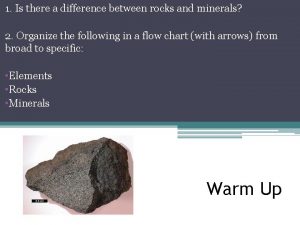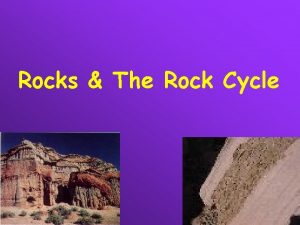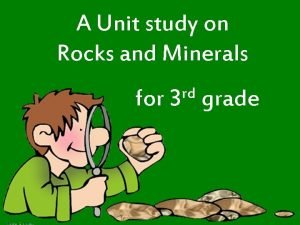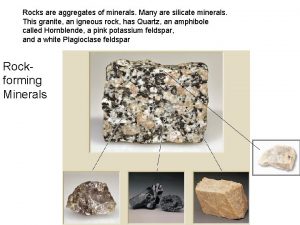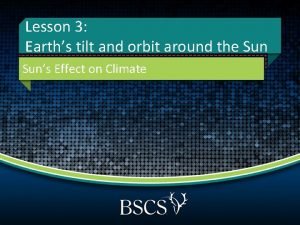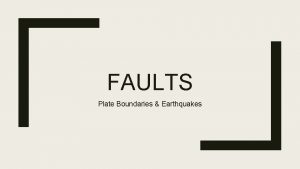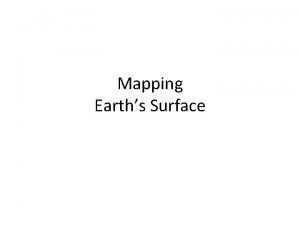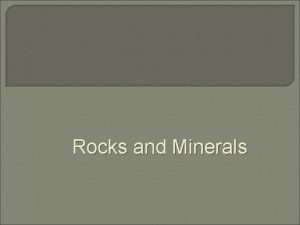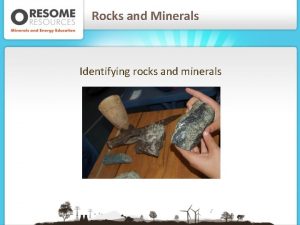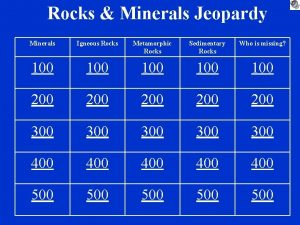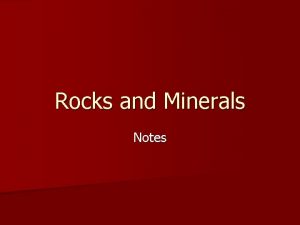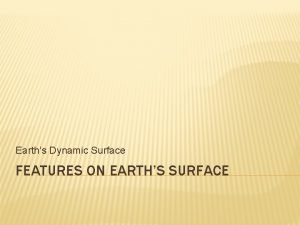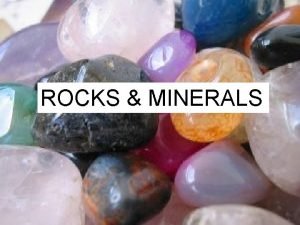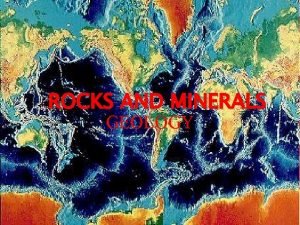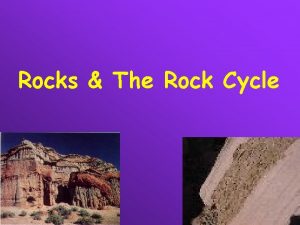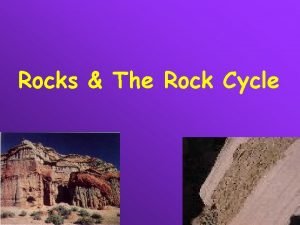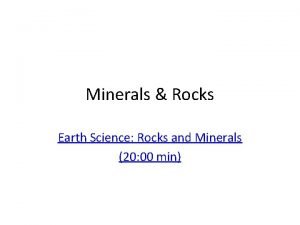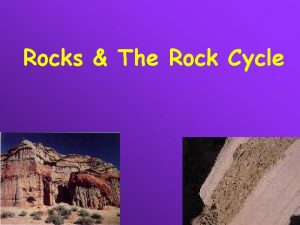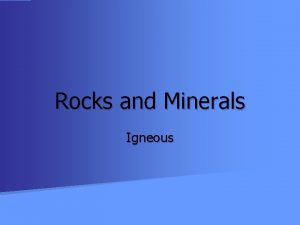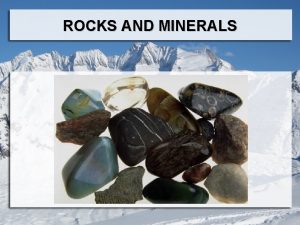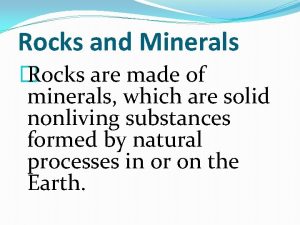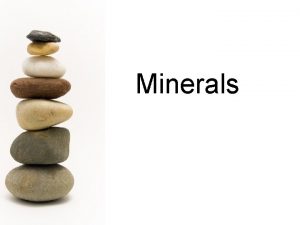EARTHS SURFACE Minerals Rocks MINERALS VS ROCKS A




















- Slides: 20

EARTH’S SURFACE Minerals & Rocks

MINERALS VS. ROCKS • A mineral is a solid formation that occurs naturally in the Earth. • A rock is a solid combination of more than one mineral formations which is also occurring naturally.

CHARACTERISTICS OF MINERALS AND ROCKS MINERALS ROCKS pure (made of same substance) more than one mineral some have crystals not single crystals usually pretty not usually as pretty usually have a shape no definite shape color is usually the same color is not the same no fossils some have fossils

APPLICATIONS OF MINERALS AND ROCKS Minerals Rocks • The commercial value of minerals is immense • Rocks are mined to extract these minerals

ROCK WORDS • mountain - huge, giant hunk of rock that is still attached to the earth's crust, doesn't move, tall • boulder - large, taller than a person • rock - large, you could get your arms around it or a bit smaller but it is usually jagged, broken off a bigger piece of rock • river rock - round rocks that are along the edge & at the bottom of fast-flowing rivers • stone - medium, you could hold it in two hands

ROCK WORDS • pebble - small, you can hold it with two fingers, could get stuck in your shoe, usually rounded • sand - made up of tiny pieces of rock, grains of sand • grain - tiny, like a grain of rice or smaller, often found on a beach • dust - really fine powder that is mixed in with sand or soil • speck - as in a speck of dirt

MINERALS • A mineral is the same all the way through. That is one reason we speak of a sample or a specimen rather than a rock. • There about 3000 known minerals on earth. • All rocks are made up of 2 or more of these minerals.

HTTP: //WWW. MINERALOGY 4 KIDS. ORG/

WHAT IS A MINERAL? • Naturally occurring • Inorganic- not living • Solid • Crystal Structure • Definite chemical composition

PROPERTIES OF MINERALS • Color– this varies depending on the chemicals present and is the least informative in identifying a mineral variety • Luster – what the surface looks like in the light • Specific Gravity– how heavy it feels • Crystal Form – shape of crystal, shape the mineral would take if it had room to grow in a cavity

PROPERTIES OF MINERALS • Cleavage– pattern when mineral is broken • Fracture Tendency- toughness, how cohesive the mineral is, if it falls apart • Hardness– what it can scratch & what scratches it • Transparency - The ability to transmit light.

LUSTER • Determined by the intensity or quality of the light reflected by its surface

LUSTER Metallic Glassy

LUSTER Waxy/Greasy Pearly

LUSTER Dull Silky

HARDNESS • Mohs hardness scale • Ranks ten minerals from softest to hardest • Can be determined by a scratch test. • A mineral can scratch any mineral softer than itself, but can be scratched by any mineral that is harder.

STREAK • The color of its powder. • Color of a mineral may vary…its streak does not. • Color of mineral and streak can often be different.

CHARACTERISTICS/PROPERTIES OF MINERALS • Naturally Occurring • Inorganic • Solid • Crystal Structure • Definite Chemical Composition

PROPERTIES USED TO IDENTIFY MINERALS • Color- provides little information • Streak- color of mineral’s powder • Luster- how light is reflected from a mineral’s suface • Hardness- determined by a scratch test. • Density- mass per unit of volume. • Crystal Systems • Cleavage and Fracture

CLEAVAGE VS. FRACTURE Cleavage Fracture • A mineral that splits easily along flat surfaces. • How a mineral looks when it breaks apart in an irregular way. • Arrangement of the atoms causes it to break more easily in one direction • Quartz
 Igneous vs sedimentary or metamorphic
Igneous vs sedimentary or metamorphic Igneous metamorphic and sedimentary
Igneous metamorphic and sedimentary Concept map magma
Concept map magma Rock type
Rock type Poem about minerals and rocks 3 stanza
Poem about minerals and rocks 3 stanza Rock cycle
Rock cycle Difference between rocks and stones
Difference between rocks and stones Minerals vs rocks
Minerals vs rocks Difference between minerals and rocks
Difference between minerals and rocks Rock type
Rock type Rocks are aggregates of minerals
Rocks are aggregates of minerals What does earths tilt do
What does earths tilt do Earths biomes
Earths biomes What is luna moon
What is luna moon Earths early atmosphere contained
Earths early atmosphere contained Atmospheric definition
Atmospheric definition The earth's layers foldable
The earth's layers foldable Brown earth soil profile
Brown earth soil profile How thick is the earths crust
How thick is the earths crust Earths boundaries
Earths boundaries Earths mantle
Earths mantle






